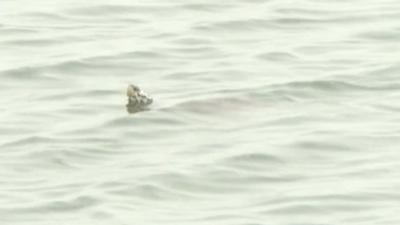BERLIN, Md. -- The Maryland Coastal Bays Program is in week two of their two week terrapin study. Each year, scientists and volunteers look on land and in our waterways to gather important data about the species' population.
Often done during late May and early June, it is one of the better times of year to try and spot a few of these surprisingly swift reptiles. In the spring, terrapins are coming up from hibernation, looking for initial food and potential mates.
On Tuesday, we went out with scientists from MCBP to Maryland's Coastal Bays. A few terrapin's heads could be spotted peaking out of the water, but if you blinked, you'd miss it.
The turtles often speedy breaks for air are only one factor that can make this study so difficult. Carly Toulan, an environmental scientist with MCBP said weather can impact the study as well.
"It can be tricky if you're coming out on a cloudier day or if the water is a bit rougher and you have a bit of chop," said Carly Toulan. "Just because you can mistake a wave for a turtle or if it's overcast it can be a bit harder with the glare."
How many volunteers offer up their assistance can also play a role in the number of turtles found. MCBP said they take all these variables into account.
In fact, it's the reason MCBP is trying to build a database, giving them years worth of knowledge to form a solid idea of how well the terrapin population is doing.
Roman Jesien, Science Coordinator for MCBP, said one task for him and the other scientists is to look at the impact of development and shoreline erosion.
"We’re afraid those turtles may have problems finding nests and being able to bring off a brood, so we’re monitoring them to see how well they’re doing and issues that we can help with," said Jesien.
While out on the water, a few sights could set off alarm bells, while others could spark future action.
"If we see no turtles that will catch our eye, if we see an area that has a lot of turtles then we’ll take a look at that and see what it is about that area that turtles really like and see if we can duplicate that in other areas," said Jesien.
Three years ago, an environmental scientist with MCBP made an adjustment to the study. Scientists and volunteers are now taking the same routes year in and year out. Toulan said this method will lead to more reliable data.
"The biggest thing is just to continue getting that data for the same sites to get a long term trend," said Toulan. "That’s how you can really figure out what’s going on."
Data collected is expected to fluctuate from year to year. For example, if you take a look at last years study, you will see a graph(Figure 1) dating back to 2011. Only 100 turtles were spotted in the water that year.
The next year, that number spiked to 328. In 2013, it dipped back down to 214 before rocketing to 423 in 2014. Those jumps in data can be attributed to the variables mentioned earlier, and it's why Jesien and Toulan say building a database will be so important.
The study wraps up on Saturday, June 10th. At that point, MCBP will compile all the data gathered and focusing on the population numbers, compare them to years past.



